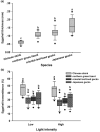The effects of light exposure during incubation on embryonic development and hatchling traits in lizards
- PMID: 27917935
- PMCID: PMC5137012
- DOI: 10.1038/srep38527
The effects of light exposure during incubation on embryonic development and hatchling traits in lizards
Abstract
Light is an environmental factor that is known to profoundly affect embryonic development in some oviparous vertebrates, but such effects are unstudied in reptiles. We investigated the light sensitivity of lizard embryos by examining the thickness and light transmittance of eggshells as well as the effect of light on embryonic development and hatchling traits in four lizard species, the Chinese skink (Plestiodon chinensis), the northern grass lizard (Takydromus septentrionalis), the oriental leaf-toed gecko (Hemidactylus bowringii) and the Japanese gecko (Gekko japonicus). The eggshells were thinner and thus had higher light transmittance in Chinese skink than the other three species. Light exposure during incubation significantly accelerated the embryonic development in all species, with higher light intensity resulting in faster embryonic development. Interestingly, light stimulation negatively influenced hatchling size and survival in skinks, but had no effect in lacertids and geckos. This interspecific discrepancy not only relates to the differences in thickness and light transmittance of eggshells, but might also reflect the differences in the reproductive habits of these species. Given the diversity of light conditions that reptile embryos face during development, studies on the response of reptile embryos to light may offer a unique opportunity to understand the mechanisms of embryonic light sensitivity in animals.
Figures




References
-
- Shutze J. V., Lauber J. K., Kato M. & Wilson W. O. Influence of incandescent and colored light on chicken embryos during incubation. Nature 196, 594–595 (1962). - PubMed
-
- Cooper C. B., Voss M. A., Ardia D. R., Austin S. H. & Robinson W. D. Light increases the rate of embryonic development: implications for latitudinal trends in incubation period. Funct. Ecol. 25, 769–776 (2011).
-
- Shafey T. M. & Al-mohsen T. H. Embryonic growth, hatching time and hatchability performance of meat breeder eggs incubated under continuous green light. Asian Austral. J. Anim. 15, 1702–1707 (2002).
-
- Villamizar N. et al.. Effects of light during early larval development of some aquacultured teleosts: A review. Aquaculture 315, 86–94 (2011).
-
- Itoh M. T. & Sumi Y. Circadian clock controlling egg hatching in the cricket (Gryllus bimaculatus). J. Biol. Rhythm 15, 241–245 (2000). - PubMed
Publication types
MeSH terms
LinkOut - more resources
Full Text Sources
Other Literature Sources

